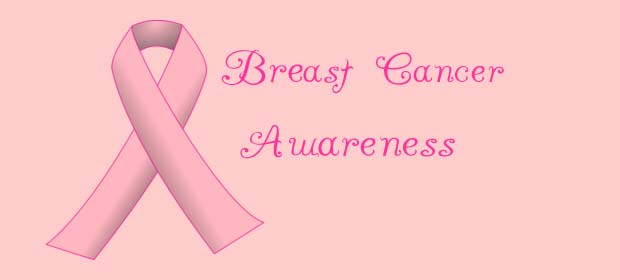National Breast Cancer Awareness Month is an annual international health campaign organized by major breast cancer charities every October to increase awareness of the disease and to raise funds for research into its cause, prevention and cure. The campaign also offers information and support to those affected by breast cancer.
As well as providing a platform for breast cancer charities to raise awareness of their work and of the disease, it  is also a prime opportunity to remind women to be breast aware for earlier detection
The best way to find breast cancer early is with a mammogram. If you are a woman age 50 years or older, be sure to have a screening mammogram every two years.
What are the symptoms of breast cancer?
When breast cancer starts out, it is too small to feel and does not cause signs and symptoms. As it grows, breast cancer can cause changes in how the breast looks or feels. Symptoms may include—
•New lump in the breast or underarm (armpit).
•Thickening or swelling of part of the breast.
•Irritation or dimpling of breast skin.
•Redness or flaky skin in the nipple area or the breast.
•Pulling in of the nipple or pain in the nipple area.
•Nipple discharge other than breast milk, including blood.
•Any change in the size or the shape of the breast.
•Pain in any area of the breast.
What is a mammogram?
A mammogram is an X-ray of the breast. Doctors use a mammogram to look for early signs of breast cancer. Having mammograms regularly can lower your risk of dying from breast cancer. If you are 50 to 74 years old, be sure to have a screening mammogram every two years. If you are 40 to 49 years old, talk to your doctor about when and how often you should have a screening mammogram.
Why should I have a mammogram?
Regular mammograms are the best way to find breast cancer early, sometimes up to three years before it can be felt. When their breast cancer is found early, many women go on to live long and healthy lives.
Where can I go to get screened?
Most likely, you can get screened for breast cancer at a clinic, hospital, or doctor’s office. If you want to be screened for breast cancer, call your doctor’s office. They can help you schedule an appointment. Most health insurance companies pay for the cost of breast cancer screening tests.
How can I lower my risk of breast cancer?
•Control your weight and exercise.
•Know your family history of breast cancer. If you have a parent, sibling, son or daughter with breast cancer, ask your doctor about your risk of getting breast cancer and how you can lower your risk.
•Find out the risks and benefits of hormone replacement therapy.
•Limit the amount of alcohol you drink.
Can men get breast cancer?
Men can also get breast cancer, but it is not very common. For every 100 cases of breast cancer, less than 1 is in men.
How many people get breast cancer each year?
In 2009 (the most recent year numbers are available)—
•211,731 women and 2,001 men in the United States were diagnosed with breast cancer.*â€
•40,676 women and 400 men in the United States died from breast cancer.*â€
*Incidence counts cover approximately 90% of the U.S. population; death counts cover approximately 100% of the U.S. population. Use caution when comparing incidence and death counts.
